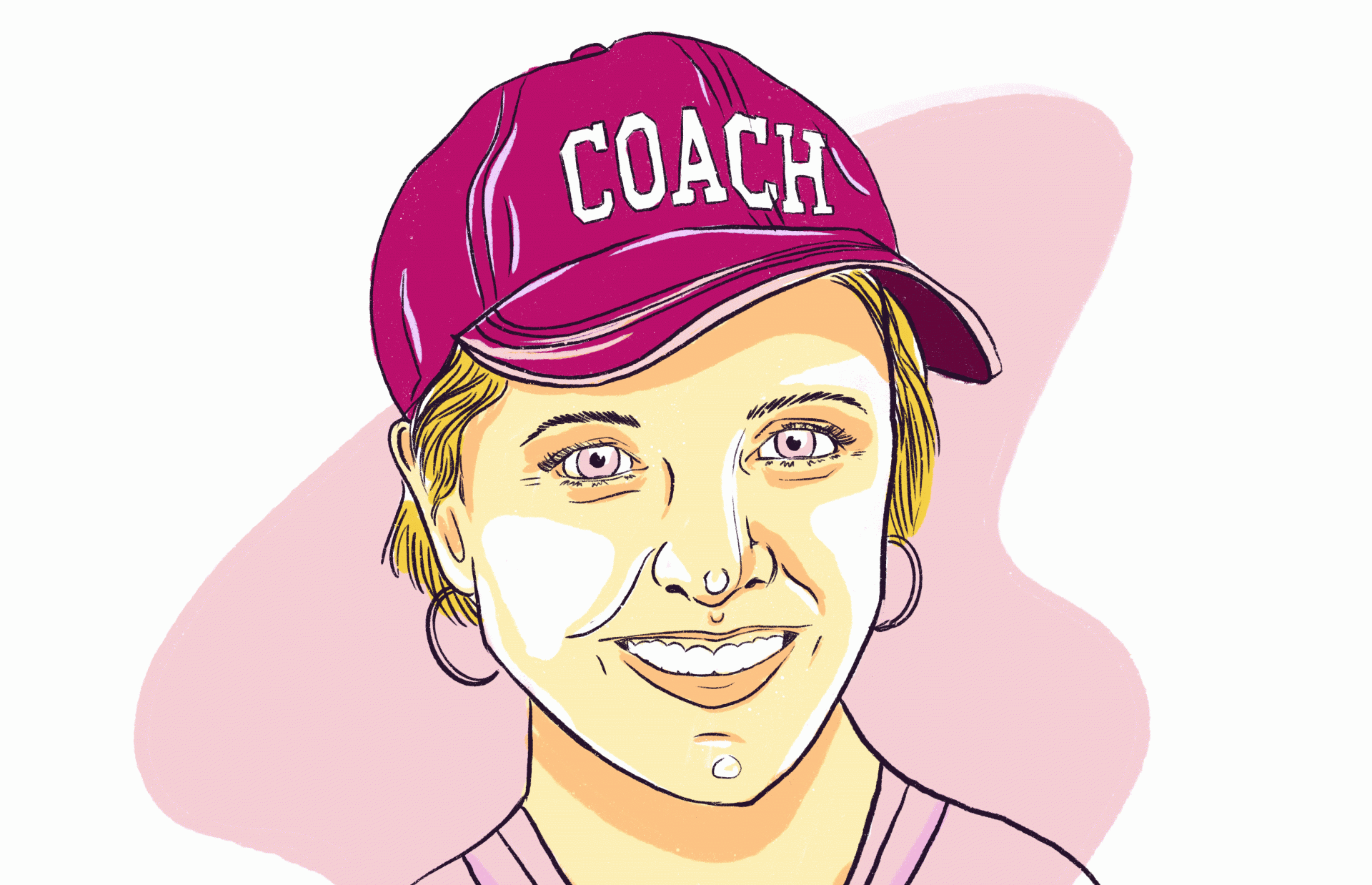Mandi Caskey

She works on the top floor of a tower in the sky. The panoramic Columbus skyline surrounds her office, the sun shining fervently onto the ants below.
We are on the 40th floor of the Rhodes Tower—the observation deck—and for months, Mandi Caskey has been working on a 26-foot-long commissioned mural for the state. Her workstation is closed to the public, sectioned off by a white sheet and a crudely drawn sign that reads, “Artist at work, do not disturb.”
This is the story of an art school dropout.
Caskey is wearing a floral black and yellow sundress; dried paint flakes carelessly fall from her clothes and fingers when she moves and speaks. Her oversized glasses slump off of her face as she greets me with a giant hug.
Caskey first moved to Columbus from Lima, Ohio when she was 18. She describes her childhood as void of culture, the only influence of creativity coming from her grandmother.
“She used to put me in a box and threw all these colored pencils and painting supplies and just let me go at it. And I would sit in there all day and just paint the entire inside of the box, you know? That’s all I did as a kid, drawing and painting, drawing and painting.”
Living in the sticks created an odd relationship for Caskey and the world around her. As the only artist in her town—not to mention the only child in her suburb—she admitted that she had no friends, spending all of her time honing her craft. When she was a sophomore in high school, her father died of a stroke after the removal of a grapefruit-sized brain tumor. This distorted her whole world.
“It happened in a period of, like, a week. It turned my world upside down. It definitely changed who I was, ’cause going into high school, I was always in trouble … kind of a rambunctious asshole.”
Due to the newly fashioned familial obligations, Caskey opted to stay in Ohio for art school, attending her first year at CCAD in 2012. To add to her destitutions, she had to make it out to Columbus and pay for school on her own.
“When I came to art school, I was just in a mode of ‘I don’t care who I meet. I don’t care who I talk to. I’m not here to make friends. I’m here to make art and be top of my class.’”
She was. Then, the second year hit and her enthusiasm for art academia began to wane.
“In my second year, nothing changed. I didn’t see progression at all. I wasn’t pushed like I was in high school. I didn’t have anybody lighting a fire under my ass, so I just got more and more depressed—especially paying it on my own. I had no money, and paying for this college that is literally showing me no outcome at this point. I just knew I wasn’t doing what I wanted to do. That was not the direction that I wanted, so I halted it.”
“Halting it” turned out to be the exact opposite for Caskey’s output as an artist.
After a brief hiatus, Mandi started doing street art, using Instagram as a mechanism for advertisement. People took note of her delicate attention to detail and stunning hyperrealism, her handle @miss.birdy now boasts over 4,000 followers. This is how she got in touch with the surrounding artistic community, landing her her first gallery show at Tacocat at 20 years old.
I met Caskey for the first time about a year later. We went on an excursion to an abandoned steel plant in Zanesville where she and her partner at the time, Jacob Tanner, lit up the decomposing factory walls with colorful murals just for practice—and, you know, funsies.
A lot has changed since then. Separation from a partner can be emotionally excruciating. For Caskey, she looked at it as an opportunity to flourish independently. She admitted to being less of a homebody, allowing her more time to make the connections necessary to make it as a professional artist.
“I just, like, needed to get out of the house. I needed to get my mind off things, and so I just kept finding new jobs and going to new events. So oddly enough, that’s what did it.”
Caskey “doing it” is exemplified in this moment, our meeting at the tippy top of Columbus’ tallest tower, creating art for the state. The mural incorporates all of Ohio’s state symbols, from the cardinal to the trilobite. At its heart, the mural is a nature scene, integrating Ohio’s four distinct seasons from left to right, while also transiting from evening to morning; the shadows in each section changing slightly to account for the sun.
Director Robert Blair, the big boss man, enters through the white sheet, inadvertently interrupting our interview. He apologizes profusely, compliments Caskey on her progress, shakes my hand, and exits. I look at her and smile. Clearly, she is in charge here.
Between her paid commissions—from construction spirit animal murals at Pins, Independents’ Day stage installations—and passion side projects, like tiny paintings on a single brick on a large building; and time working as a shop manager at Memento Tattoo, Caskey is busy.
“I wake up sometimes at like 6 a.m. and don’t go to bed until 2 a.m.—it’s exhausting, and I’m honestly afraid that I’m gonna overwork myself to the point where I can’t move, you know? Shit gets real, and hard, and scary, but it’s in those moments that you realize who you are and what you’re capable of.”
Considering all the shit Caskey has gone through, it is exciting to see what she will be capable of next.
BROUGHT TO YOU BY



